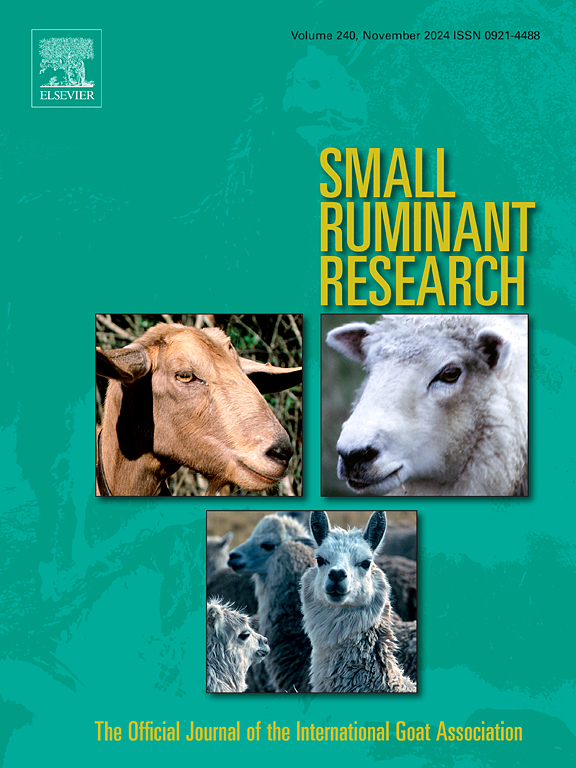Association analysis of single nucleotide polymorphisms of LMOD3 gene and feed efficiency in sheep
IF 1.6
3区 农林科学
Q2 AGRICULTURE, DAIRY & ANIMAL SCIENCE
引用次数: 0
Abstract
Feed efficiency is a crucial target traits in livestock production. The LMOD3 gene is involved in the assembly and stability regulation of actin fibers in muscle cells.The member related to the formation of actin filaments A is significantly associated with the high feed efficiency group. The idea of this paper was to explore the influence of the LMOD3 gene polymorphism on the feed efficiency of Hu sheep. In this investigation, 984 male Hu sheep aged 120–140 days were meticulously evaluated for key parameters including body weight (BW), feed intake (FI), and feed conversion ratio (FCR). The polymorphic locus of LMOD3 gene was identified by sanger sequencing. The expression level of the LMOD3 was measured by reverse transcriptional quantitative polymerase chain reaction (qRT-PCR). The results showed that LMOD3 was mutated from C to A at the 33976909 base of intron 1. The results of association analysis showed that the FCR of AA genotype was significantly lower than that of CC genotype (P < 0.05), and the ADG of AA genotype was significantly higher than that of CC genotype (P < 0.05). qRT-PCR results revealed that the mRNA expression of LMOD3 in muscle was significantly higher than that in other tissues, except spleen (P < 0.05). The expression levels of different genotypes in muscle tissue showed that AA genotype was significantly higher than CC genotype. In short, LMOD3 may potentially regulate the feed efficiency of Hu sheep. The findings of this research have established a theoretical framework for understanding the growth and development of Hu sheep.
绵羊LMOD3基因单核苷酸多态性与饲料效率的关联分析
饲料效率是畜牧生产的一项重要指标。LMOD3基因参与肌动蛋白纤维在肌肉细胞中的组装和稳定性调控。与肌动蛋白丝A形成相关的成员与高饲料效率组显著相关。本研究旨在探讨LMOD3基因多态性对湖羊饲料效率的影响。选取120 ~ 140 日龄雄性湖羊984只,对其体重(BW)、采食量(FI)和饲料系数(FCR)等关键参数进行了详细评价。采用sanger测序法鉴定LMOD3基因多态性位点。采用逆转录定量聚合酶链反应(qRT-PCR)检测LMOD3的表达水平。结果表明,LMOD3在内含子1的33976909碱基上由C突变为A。关联分析结果显示,AA基因型的FCR显著低于CC基因型(P <; 0.05),AA基因型的ADG显著高于CC基因型(P <; 0.05)。qRT-PCR结果显示,肌肉中LMOD3 mRNA的表达量显著高于除脾脏外的其他组织(P <; 0.05)。不同基因型在肌肉组织中的表达水平表明,AA基因型显著高于CC基因型。综上所述,LMOD3可能对湖羊的饲料效率有潜在的调节作用。本研究结果为认识湖羊的生长发育建立了理论框架。
本文章由计算机程序翻译,如有差异,请以英文原文为准。
求助全文
约1分钟内获得全文
求助全文
来源期刊

Small Ruminant Research
农林科学-奶制品与动物科学
CiteScore
3.10
自引率
11.10%
发文量
210
审稿时长
12.5 weeks
期刊介绍:
Small Ruminant Research publishes original, basic and applied research articles, technical notes, and review articles on research relating to goats, sheep, deer, the New World camelids llama, alpaca, vicuna and guanaco, and the Old World camels.
Topics covered include nutrition, physiology, anatomy, genetics, microbiology, ethology, product technology, socio-economics, management, sustainability and environment, veterinary medicine and husbandry engineering.
 求助内容:
求助内容: 应助结果提醒方式:
应助结果提醒方式:


